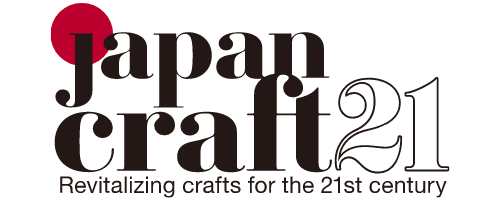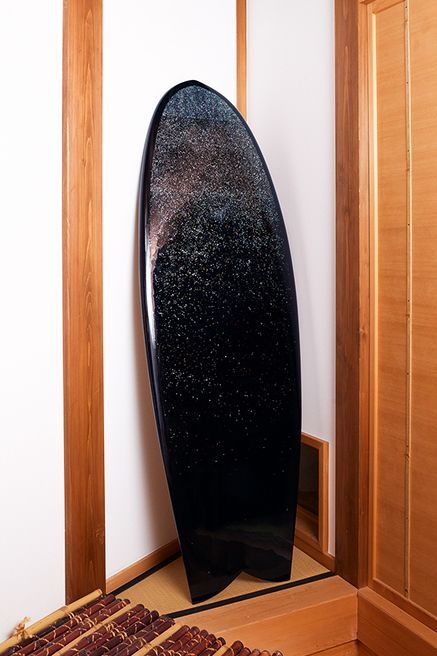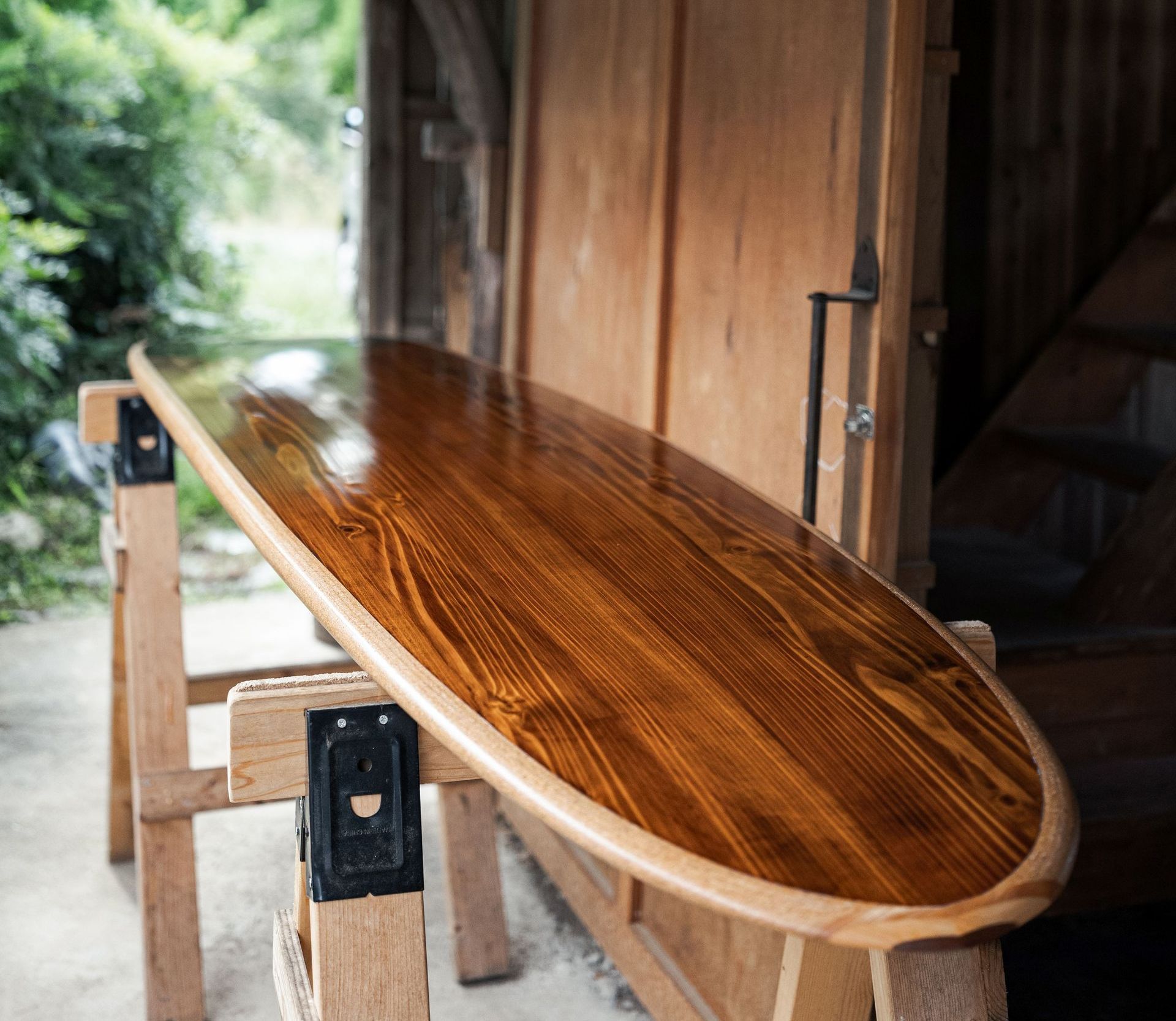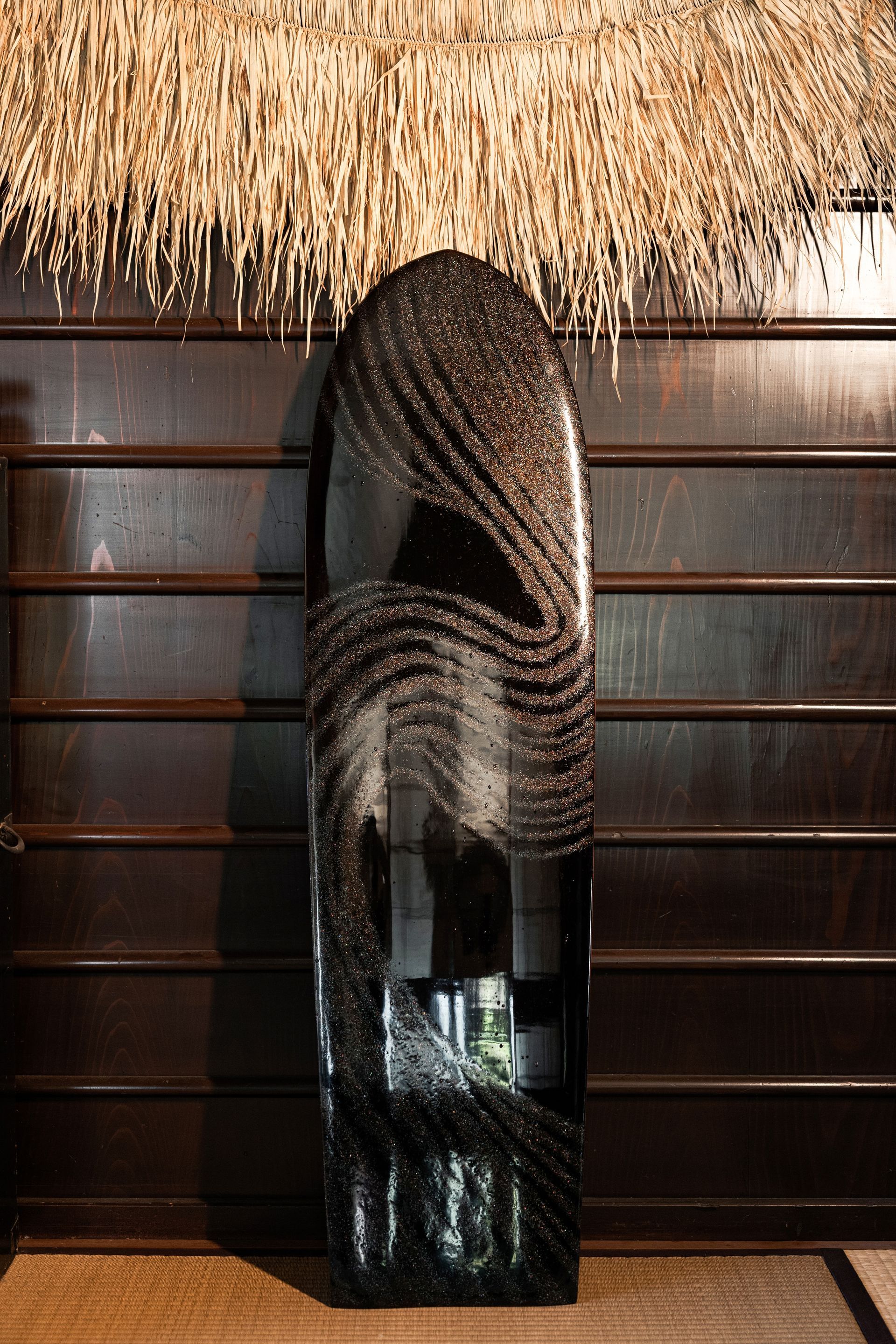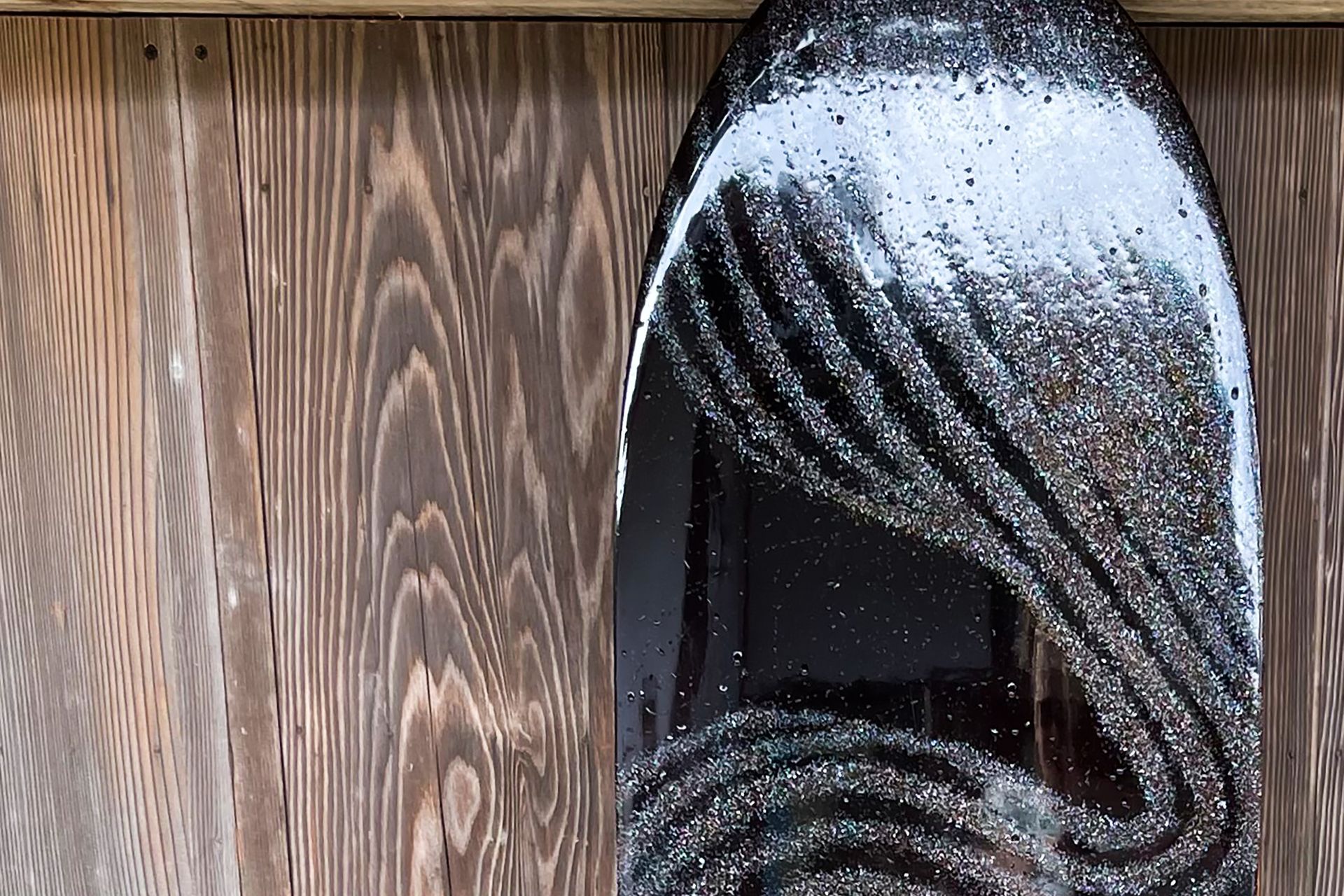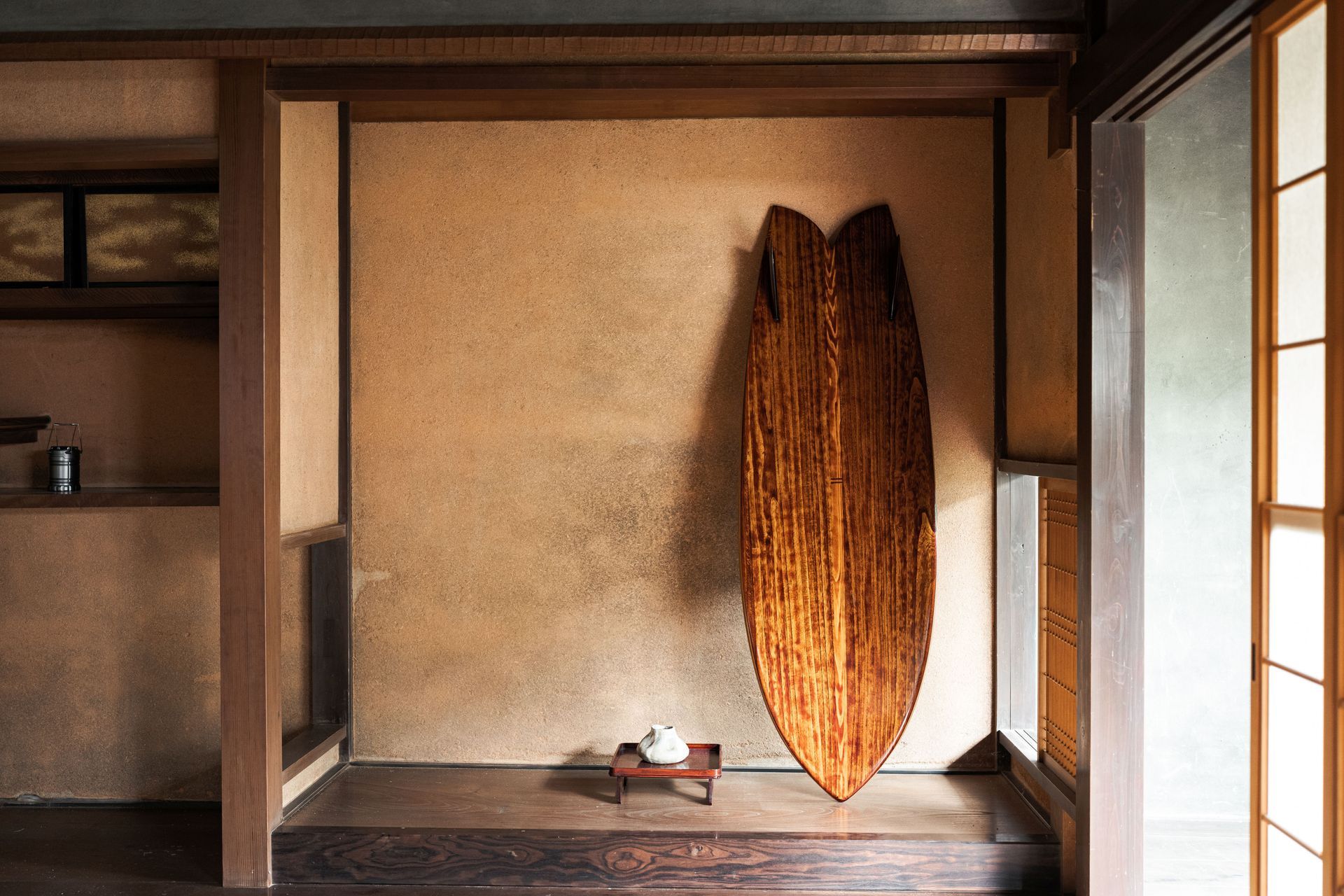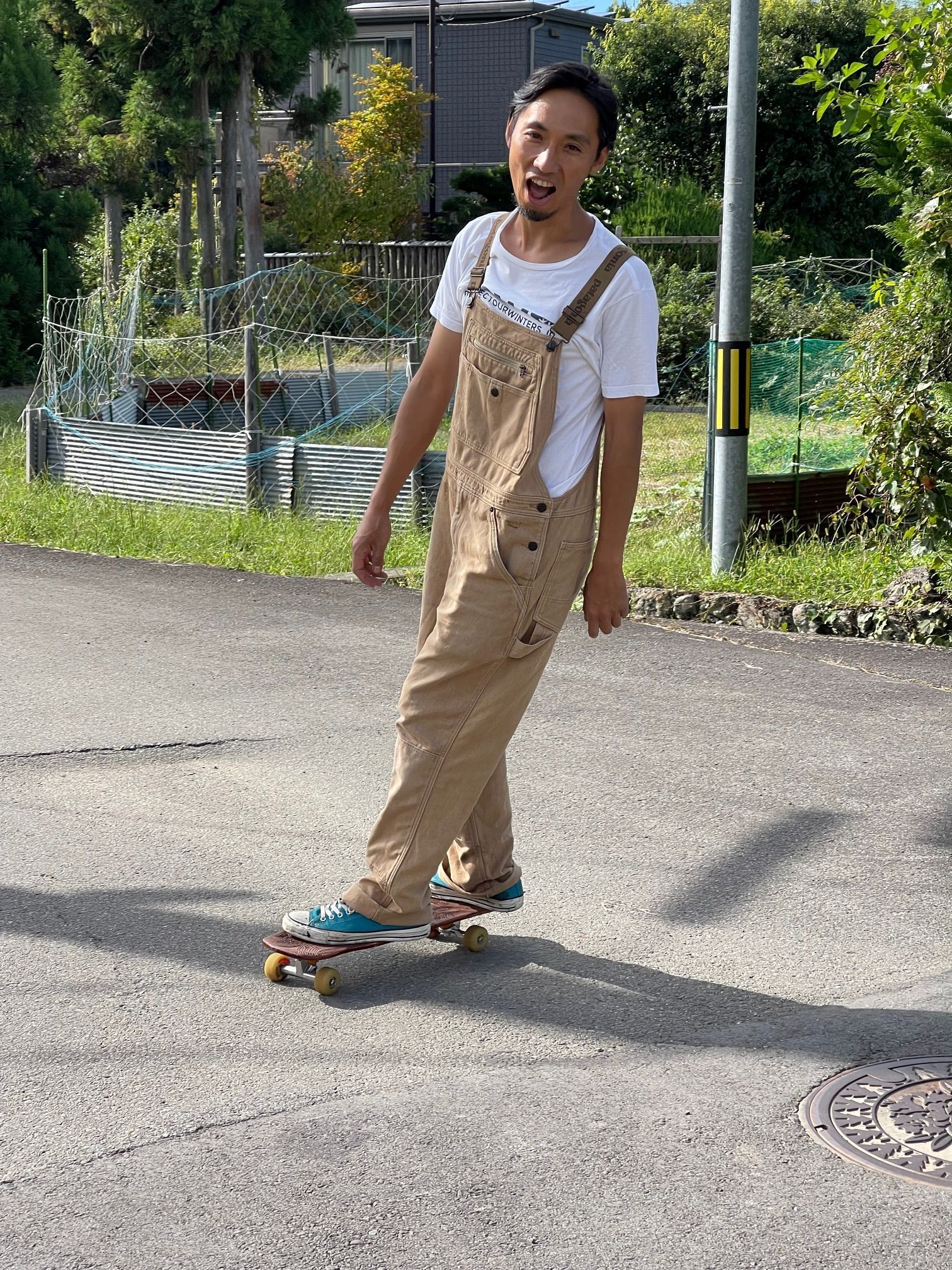Click Image to Enlarge
Write whatever you want about this artwork.
This surfboard was constructed with native Japanese paulownia wood, known for the greatest strength-to-weight ratio of any commercially used wood in the world. The wooden board is then coated with layers of thick, precious urushi lacquer paste. Finally, seashell is embedded into the still wet urushi, creating an original mother-of-pearl surfboard.
Takuya TSUTSUMI
Urushi (Lacquer) Art ・ Kyoto
-
Artist's Story
Takuya TSUTSUMI creates wooden lacquer surfboards and skateboards, and is involved in craft-based rural community revitalization.
The First Prize winner of the 2021 Japan Traditional Craft Revitalization Contest, Tsutsumi grew up as a 4th-generation lacquer dealer in a very traditional Kyoto neighborhood where his family has worked for 114 years. His prize-winning vision centers on the expansion of Perspective, an NPO eco-community he helped create which focuses on raw materials, crafts people, and users.
Tsutsumi holds a great enthusiasm for the outdoors; he has been an avid snowboarder, skateboarder, and surfer since his early years. With the financial support and mentoring of JapanCraft21, he established Siita (a surfboard and skateboard manufacturing business) which combines his passion for the outdoors with a viable business to support Perspective’s development.
Using domestically grown Paulownia and Japanese cedar, the surfboards are not only lightweight, but when coated with Japanese urushi 漆 (lacquer) they last longer, are more durable and are easier to repair than conventional chemical-based boards. Tested by surfers internationally, these boards have even been found to surf better.
In addition to Tsutsumi’s reasonably priced boards with a standard urushi finish, he produces specialty boards using traditional Japanese craft techniques, such as mother-of-pearl, gold leaf, and many kinds of wood inlay. Wooden urushi-coated skateboards also come in both standard and highly crafted versions.
-
About the Craft
Urushi 漆, a completely natural lacquer coating, has been in use in Japan for 9,000 years. It is the world’s hardest and most durable coating, and can be applied to wood, metal, bamboo, glass, even over hemp cloth (known as “dry lacquer”). Not only it is a protective coating but it has anti-bacterial properties, is easy to clean, and increases the longevity of whatever it is applied to. Clear urushi coating on wood appears more lustrous and beautiful over time, and the wood grain becomes more prominent.
The clear, honey-colored sap from the lacquer tree (Rhus vernacifera) is collected by hand from incisions on the tree trunk; total output of the precious substance which can ever be extracted from one tree is only six ounces (177 cc). Mineral pigments can be added to create any color, such as iron oxide for black urushi or red iron oxide for red urushi.
During the Heian period (792 - 1185), lacquer-coated wooden functional ware was very popular and Japan became Asia’s undisputed lacquer master during the Golden Age of lacquerware which followed. The Portuguese introduced it to the west in the 16th century and it was widely spread in the 17th century by the Dutch East India Company, enthralling royalty and nobility alike. Marie Antoinette amassed a famous collection of lacquerware items. Japanese urushi ware dazzled the west as Japanism spread during the Belle Époque.
Mother-of-pearl inlay is a process of embedding pieces taken from the iridescent inner layer of mollusk shells (abalone or oyster shell, etc.) into urushi. The pieces of shell are arranged in decorative motifs and most often cover a wooden base. The Japanese adopted this methodology from the Chinese in about the 7th century CE.
Maki-e, the most famous urushi decorative technique, is a 1200-year old, native Japanese process involving the sprinkling of gold or silver power on a decorative design of still wet urushi. Makie motifs can either be in burnished, flat or 3-dimentional raised form.
Hyomon is the embedding of metal sheet as an inlay on an urushi surface
Chinkin is the application of gold into decorative patterns which are incised into the surfaces of urushi vessels.
Kinma involves incising decorative motifs in an urushi surface and filling it with colored urushi. It is believed to have originated in Southeast Asia.
Choshitsu is carved lacquer achieved by applying many layers of colored lacquer, usually to a wooden surfaces, then using a metal carving knife to engrave 3-dimensional designs. It takes at least 100 layers of urushi to achieve 3mm for carving. The technique most probably came from China about 800 years or more ago.
-
Click Image to Enlarge
ButtonAnother view of the main image above. Paulownia wooden surfboard coated with layers of thick, urushi lacquer paste and embedded with seashell resulting in an original mother-of-pearl surfboard.
-
Button
A paulownia wooden surfboard coated with many layers of translucent urushi lacquer, for a deep mirror-like shine. The cushion edging is cork.
-
Click Image to Enlarge
ButtonThe fins of a wooden surfboard coated with many layers of translucent urushi lacquer, for a deep mirror-like shine.
-
Click Image to Enlarge
ButtonPaulownia wooden surfboard coated with layers of thick, urushi lacquer paste and embedded with seashell set in a wave pattern on this original mother-of-pearl surfboard.
-
Click Image to Enlarge
ButtonA close-up view of the Paulownia wooden surfboard coated with layers of thick, urushi lacquer paste and embedded with seashell set in a wave pattern on this original mother-of-pearl surfboard.
-
Button
A paulownia wooden surfboard coated with many layers of translucent urushi lacquer, for a deep mirror-like shine.
-
Click Image to Enlarge
ButtonA paulownia wooden surfboard coated in a mottled, reddish urushi lacquer finish. The blackened bottom of the underside of the urushi lacquered cedar skateboard is where a bear repeatedly rubbed its back in the forest.
-
Click to Enlarge Image
ButtonTakuya TSUTSUMI creates wooden lacquer surfboards and skateboards, and is involved in craft-based rural community revitalization. Additionally, he is one of Japan’s leading experts in Japanese urushi lacquer, and a lover of all board sports.
CONTACT ・ Takuya TSUTSUMI
Website: Urushi no Ippo
Website: Tsutsumi Asakichi Lacquer Shop
Website (English): Beyond Tradition
Website (English): Forest of Craft
Japancraft21:
Email Us
